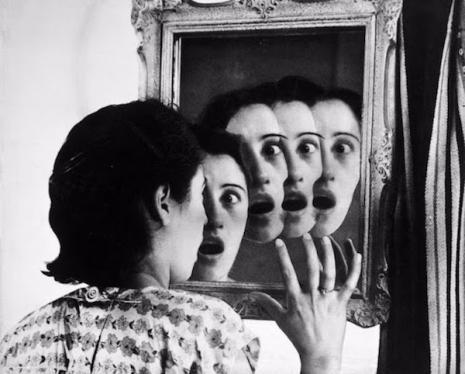
In 1948, the photographer Grete Stern was asked to contribute photographic illustrations for a weekly column on the interpretation of dreams in the Argentinian women’s magazine Idilio. The column entitled “El psicoanálisis le ayudará” (“Psychoanalysis will help you”) was written by Italian sociologist Gino Germani under the novel pseudonym of Richard Rest. Psychoanalysis was then considered the cure-all for everyone’s ills—though goodness knows what strange subconscious thought inspired Germani to choose the name “Dick” Rest….
Anyway…while Rest analyzed one of the many dreams submitted by the mainly working-class female readership, Stern produced a photomontage that recreated some aspect of the reader’s dream. These illustrations usually depicted women struggling to free themselves from the oppressive patriarchy of Argentinian society.
For example, in one image a woman is trying to communicate on a phone without a mouth. In another, a woman is trying to grow in the light which can be turned off on a whim by a giant man’s hand. Or there is the woman whose reflection in a mirror has shattered into fragments, or the woman housed in a birdcage like some exotic bird. And so on. During her tenure with Idilio, Stern produced around 150 photomontages between 1948 and 1951.
Grete Stern was born in Elberfeld, Germany, on May 9th, 1904. Her family were involved in the textile and fabric industry and made frequent visits on business to England, where Stern first attended school. Returning to Germany, Stern studied graphic design and typography at the Kunstgewerbeschule in Stuttgart between 1923-25. After college, she became a freelance graphic designer producing adverts for magazines and papers. However, it was after seeing an exhibition by the American photographer Edward Weston, that Stern decided on a career as a photographer.
Stern moved to Berlin where she became a photographic student under the tutelage of Walter Peterhans. Stern later said that Peterhans taught her that the camera was not just a mechanism for taking pictures but a whole new way of seeing. Peterhans went onto become the leading photographer with the Bauhaus movement. During her studies, Stern became close friends with another pupil Ellen (Rosenberg) Auerbach. Together they formed the advertising and portrait studio ringl+pit. The company name was concocted from the pair’s nicknames—Ringl for Grete and Pit for Ellen. Their work became highly successful—in particular their mixing of photographic images with text. During this time, Stern met and started a relationship with Argentinian photographer Horacio Coppola.
When Adolf Hitler and his band of Nazi thugs came to power, Stern left ringl+pit and moved with Coppola to England where she formed her own studio in 1934. Here she documented many of the German exiles like Bertolt Brecht and Helene Weigel. In 1935, Stern and Coppola married. With the threat of war more apparent, Stern and Coppola moved to Buenos Aires, where they set up a graphic, advertizing, and photographic studio and held the first major exhibition of “modern photography” in the city.
Stern was way ahead of the curve. She was a pioneer for women working in a male-dominated and, let’s be honest, primarily sexist industry. Stern became a highly successful and inventive portrait photographer with her work exhibited and published across the world. However, the photomontages she produced for Idilio were long discounted as just hack work until their reassessment labeled them as what they are: powerful, imaginative, feminist artwork.
Stern died at the age of 95 in 1999.



More of Grete Stern’s dream work, after the jump…





